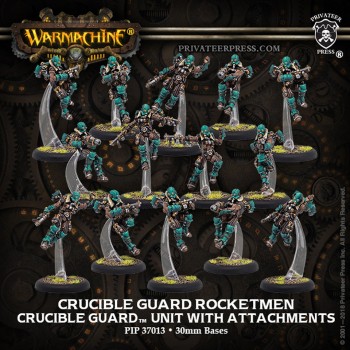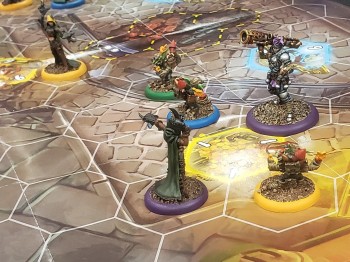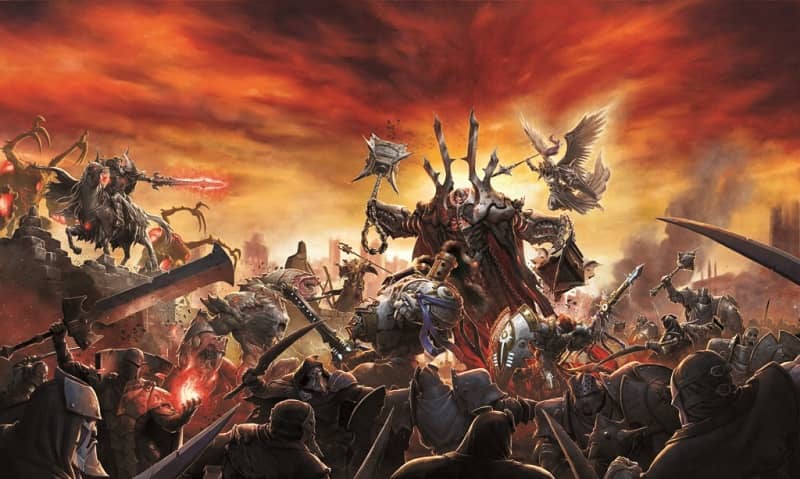Evolution of the Iron Kingdoms
For twenty years, the folks at Privateer Press have been creating games, primarily set in their Iron Kingdoms steampunk fantasy setting. They began with a series of RPG volumes, including an award-winning trilogy of adventures from 2001. These adventures, later collected into The Witchfire Trilogy, was built on the D20 System from Dungeons and Dragons 3E.
Then Privateer Press really came into their own with the introduction of the Warmachine miniature wargame, focusing on armies that control massive metallic warjacks, one of the iconic creatures from their Iron Kingdoms setting.
It was Warmachine that got me into their world, in about 2005. I like heroes, so I went with Cygnar, the faction that is most stereotypically the classical honorable kingdom of knights and warriors. For those who aren’t inclined toward heroism, there was the religious fanatic Protectorate of Menoth and the undead Cryx. And for those in the middle, there was Khador, thematically based on Russia and known for having the most massive, hulking warjacks in the game. And missiles. Lots of missiles. This miniature line expanded, through Hordes, into battles with savage monstrous warbeasts, fully compatible with Warmachine. The Hordes included the blighted Legion, the druidic Circle of Orboros and their werecreatures, the Trollbloods and their giant troll cousins, and the sadistic Skorne.
It was actually my reviews of Privateer Press – both their wargame line and the RPG supplements – that first landed me in the pages of Black Gate, back in Spring of 2007 in Black Gate 10, when Black Gate actually had physical pages.
Fast forward over a decade, and Privateer has expanded into a wealth of other types of games. They’ve created fun standalone games in their Bodger Games imprint, expanded the storyline of their Iron Kingdoms setting through the novels of their Skull Island fiction imprint, and also created a bunch of science fiction horror games in their line of Level 7 series. Their Monsterpocalypse, now in a new and updated second edition, allows players to battle it out as giant mechs and kaiju-style monsters across devastated cityscapes.
 Through it all, Privateer Press maintained their focus on the core Warmachine and Hordes games. A steady stream of new, though often more limited, factions … the elven Retribution of Scyrah, the clockwork Convergence of Cyriss, and the dark fae Grymkin … have kept players engaged, along with updates and new releases of models for their existing core factions.
Through it all, Privateer Press maintained their focus on the core Warmachine and Hordes games. A steady stream of new, though often more limited, factions … the elven Retribution of Scyrah, the clockwork Convergence of Cyriss, and the dark fae Grymkin … have kept players engaged, along with updates and new releases of models for their existing core factions.
I’ll confess that I wasn’t an avid player for that whole time. For the better part of a decade – mostly coinciding with my kids being young – I had little time to devote to painting the miniatures I had, let alone to playing the game. My enthusiasm returned at GenCon several years back, when I learned about the upcoming Crucible Guard faction, alchemists who wield their explosive and corrosive weaponry across the Iron Kingdoms, along with their units of Rocketmen. This helped revitalize my interest in the game, and for the last couple of years I’ve had a monthly Warmachine and Hordes game (colloquially called Warmahordes) with several friends.
Despite some major plotline revelations that have been reflected in the game with new miniatures, the new faction released in fall 2019 represented a more substantial transformation in their game setting. The Infernal faction uses mechanics distinct from the Warmachine or Hordes factions, though they are compatible with both. These Lovecraftian monstrosities devour souls, and the narrative of the Iron Kingdom is shaken by their arrival. Kingdoms have fallen. Enemies have united. The story begins in the campaign book for Warmachine: Oblivion, but continues in regular postings through the HengeHoldScroll Twitter feed. If you want to play on the side of the Infernals, you can either assemble a full Infernal army or you can play with existing factions who are either assisting or being manipulated and corrupted by the Infernals.
 The end result of Oblivion isn’t entirely known yet, but another GenCon 2019 release gave hints of the post-apocalyptic reality that we can expect moving forward. Riot Quest is an arena battle game where you move through a map with miniatures to try to gain more treasure than your opponents. The models available in the Riot Quest core game or from the various expansion boosters are usable not only within Riot Quest, but also as solo models within Warmachine and Hordes. They’ve just recently announced a second wave, Wintertime Wasteland, that will include a new starter box and series of individual model expansions.
The end result of Oblivion isn’t entirely known yet, but another GenCon 2019 release gave hints of the post-apocalyptic reality that we can expect moving forward. Riot Quest is an arena battle game where you move through a map with miniatures to try to gain more treasure than your opponents. The models available in the Riot Quest core game or from the various expansion boosters are usable not only within Riot Quest, but also as solo models within Warmachine and Hordes. They’ve just recently announced a second wave, Wintertime Wasteland, that will include a new starter box and series of individual model expansions.
If you think that sounds good, then you’ll really want to see what they’re working on next … the science fiction miniature wargame Warcaster.
Related Articles and Resources:

[…] (Black Gate): For twenty years, the folks at Privateer Press have been creating games, primarily set in their […]
[…] (Black Gate): For twenty years, the folks at Privateer Press have been creating games, primarily set in their […]